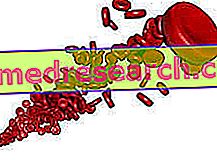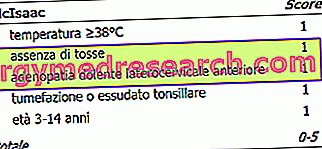Generality
The World Health Organization (WHO) has defined the concept of anemia as a hemoglobin value of less than 14 g / dl in humans, 12 g / dl in women and 11 g / dl in pregnant women.
Among the many causes of anemia, iron deficiency is the most common. Not surprisingly, iron deficiency probably represents the most widespread nutritional alteration in the world. Although the incidence of iron deficiency anemia is higher in developing countries, this form of anemia is also common in industrialized ones, especially in young children, adolescents and women of reproductive age.
Epidemiology

In the most developed countries, the incidence of iron deficiency is 3% among adult men, 20% among women and 50% among pregnant women. Percentages, these, destined to rise when some countries in Africa or Asia are examined, where a reduced diet and an excessive loss of iron caused by the presence of intestinal parasites cause iron deficiency anemia to affect more than 50% of the population.
Among adults it is mainly the female sex that is affected, particularly during childbearing age.
The trend in men is different, in which two peaks of incidence are recognized: during adolescence and after 30 years.
However, the maximum incidence of anemia occurs between 6 and 20 months of life (indifferently males and females) and in particular in premature babies. Finally, iron deficiency is more frequent in the lower classes than in the upper-middle classes (61% against 39%).
Causes of anemia
A state of iron martial deficiency can be determined by:- inadequate contribution;
- inadequate absorption;
- increased needs;
- protracted loss of iron.
Inadequate iron intake
Food shortages are a rare cause of anemia in industrialized countries that have abundant sources of supply (including meat), so about two-thirds of the iron in the diet is in the form of haem groups readily absorbable. Therefore a diminished contribution without there being problems of absorption or demand is a rare event.
The situation in developing countries is quite different, in which food is less abundant and the diet, mainly vegetarian, contains inorganic iron (not linked to heme), which is not very absorbable.
However, despite the availability of iron, a diet can often prove inadequate in privileged societies when we are in the following circumstances:
- the elderly often follow very restricted diets, containing little meat for economic reasons or due to the altered conditions of their teeth.
- Adults on a strictly vegetarian diet because, even though fruits and vegetables contain decent percentages of iron, it is equally true that there are nitrates, phosphates and fibers that tend to chelate (bind) iron and reduce its absorption.
- The poorest individuals, often belonging to minorities, are most at risk.
- The infantile age is also at high risk of anemia, as the diet, consisting mainly of milk, contains very small amounts of iron.
- Alcoholics, as they tend to have poor quality food.
- Children, especially during the first years of life, have critical needs of dietary iron to support the growth of muscle mass and to expand blood volume, and these quantities are often not compensated for by dietary intake.
Inadequate Iron Absorption
A reduced absorption of iron is observed in conditions of intestinal steatorrhea (presence of fats not absorbed in feces), in chronic diarrhea, in patients who have undergone surgical operations with large resections of the jejunum or ileum (due to reduction of the absorbent surface) and in those suffering from poor acid secretion in the stomach (hypochloridria).
Furthermore, the resection of a portion of the stomach (gastrectomy) alters the absorption of iron by decreasing the secretion of hydrochloric acid and shortening the transit time of food from the stomach itself to the duodenum. Finally, some foods present in the diet mentioned previously alter the absorption.
Increased Iron Need
The increase in demand is an important possible cause of iron deficiency anemia. Growing children, adolescents and women during the menstrual cycle and during pregnancy have a much greater need for iron than adult individuals. Women with multiple and frequent pregnancies are particularly at risk.
Protracted Iron Loss
Chronic blood loss is the most important cause of iron deficiency in the Western world.
Bleeding inside the tissues or in the body cavities can be followed by a complete recovery with reuse of the iron, while the external bleeding exhausts its reserves. These losses can occur in women of child-bearing age (menstrual flow and pregnancy), in the gastrointestinal tract or in other locations.
Gastrointestinal bleeding causes ferropriva anemia especially in elderly patients and post-menopausal women. Among these, the most frequent lesions are hemorrhoids, hemorrhagic gastritis, gastric or duodenal ulcer, hiatal hernias, diverticula, especially those of the colon and that of Mekel (congenital diverticulum of the small intestine), colon cancer and that of the stomach, inflammatory bowel diseases (ulcerative colitis and Crohn's disease), hooked worm worms and pinworms and the abuse of anti-inflammatory drugs such as aspirin.
Other sources of non-gastrointestinal bleeding can be found in the lung, in the case of pneumonia or bronchopneumonia with hemoptysis (spitting blood) or in idiomatic pulmonary hemosiderosis, in the kidney, in the case of chronic renal inflammation, kidney tumors, of the urethra or bladder, which all lead to hematuria (presence of blood in the urine) macroscopic or microscopic, at the female genital level, in the case of cancer of the uterus or menorrhagia (abundant menstrual bleeding), in states of chronic hemolysis (rupture of red blood cells) due to the presence of prosthetic heart valves, in blood donors, and finally in those suffering from paroxysmal nocturnal hemoglobinuria (haemolytic anemia).



